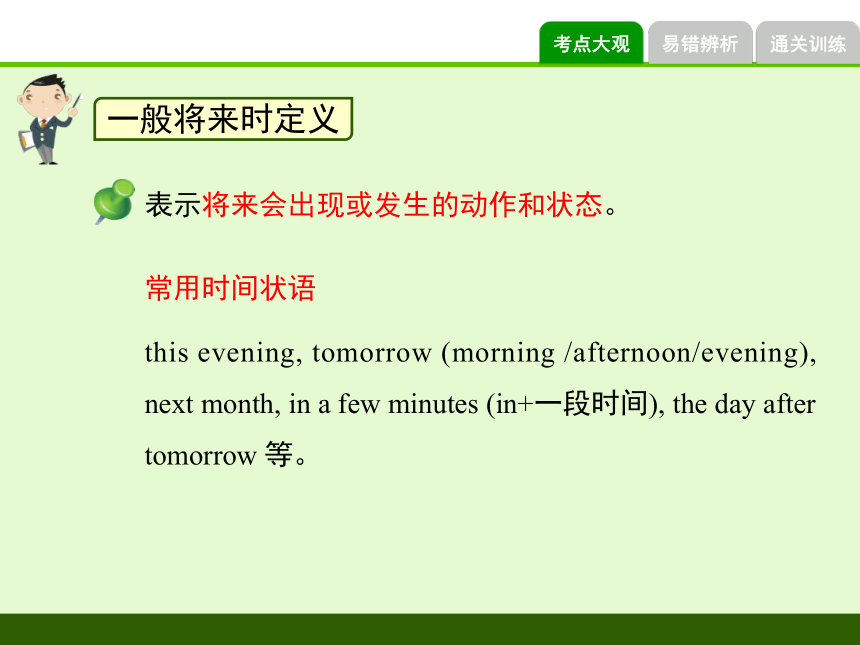外研版七年级英语下册 Module3_语法专项课件(一般将来时1)(12张)
文档属性
| 名称 | 外研版七年级英语下册 Module3_语法专项课件(一般将来时1)(12张) |  | |
| 格式 | ppt | ||
| 文件大小 | 1002.5KB | ||
| 资源类型 | 教案 | ||
| 版本资源 | 外研版 | ||
| 科目 | 英语 | ||
| 更新时间 | 2022-06-11 20:59:26 | ||
图片预览






文档简介
(共12张PPT)
Module3
语法专项课件
(一般将来时1)
初中英语外研版七年级下册
表示将来会出现或发生的动作和状态。
一般将来时定义
常用时间状语
this evening, tomorrow (morning /afternoon/evening), next month, in a few minutes (in+一段时间), the day after tomorrow 等。
一般将来时两大结构
will/shall+动词原形
be going to +动词原形
It is going to rain. 马上就要下雨了。
Which book shall I read first?
我先读哪一本书呢?
Will you be at home at seven this evening?
今晚7点你会在家吗?
be going to + 动词原形构成一般将来时,表示计划或根据某些现象或征兆预测不久即将发生的事情。含有“打算”之意。
be going to +动词原形
We are going to visit our friends tonight.
我们今晚要去拜访我们的朋友。
They are going to fly to Australia the day after tomorrow.
后天他们将飞往澳大利亚。
be going to +动词原形
be going to引导将来时句式结构
肯定句形式:主语 + be going to + do sth.
疑问句形式: be +主语 + going to + do sth.?
Tom is not going to see a film tomorrow.
Is Tom going to see a film tomorrow
Tom is going to see a film tomorrow.
否定句形式:主语 + be + not +going to + do sth.
易错点
一般将来时易混句式
用来表示按照主观意图打算或按计划、安排将要做的事,有“打算,就要”的意思。
1. “shall或will+动词原形”
也常用于表示从迹象上表明将要发生的事情,多指个人主观臆断的推测。
指对将来事物近期或远期的预见,表达个人主观意图以及征求对方意见或表示客气的邀请。
在书面语中,shall多用于第一人称;在口语中,will可以用于任何人称。
2. “be going to+动词原形”结构
易错点
Look at the clouds. There is going to be a rain.
看看这些云,暴风雨要来 了。
I hope it will be warm tomorrow.
我希望明天会暖和起来。
(即将发生)
(主观意愿)
一般将来时易混句式
【典例1】My sister wants a new dress. She ____ it to the party.
A. wears B. is going to wear
C. wore D. has worn
考查动词的时态。句意:我妹妹想要一条新裙子。她想派对上穿。由My sister wants a new dress可知动作还未执行,故用be going to形式,表示有计划做某事。
【典例2】He ________ her a beautiful hat on her next birthday. A. gives B. gave C. will giving D. is going to give
考查动词的时态。句意:他将在她下一个生日的时候送给她一顶漂亮的帽子。next birthday为将来时标志词,根据be going to+动原结构,答案选D。
【典例3】 The day after tomorrow they ________ a volleyball match. A. will watching B. watches C. is watching D. are going to watch
考查动词的时态。句意:后天,他们将看一场排球赛。The day after tomorrow为一般将来时标志词,选用将来时结构be going to do,故答案选D。
Module3
语法专项课件
(一般将来时1)
初中英语外研版七年级下册
表示将来会出现或发生的动作和状态。
一般将来时定义
常用时间状语
this evening, tomorrow (morning /afternoon/evening), next month, in a few minutes (in+一段时间), the day after tomorrow 等。
一般将来时两大结构
will/shall+动词原形
be going to +动词原形
It is going to rain. 马上就要下雨了。
Which book shall I read first?
我先读哪一本书呢?
Will you be at home at seven this evening?
今晚7点你会在家吗?
be going to + 动词原形构成一般将来时,表示计划或根据某些现象或征兆预测不久即将发生的事情。含有“打算”之意。
be going to +动词原形
We are going to visit our friends tonight.
我们今晚要去拜访我们的朋友。
They are going to fly to Australia the day after tomorrow.
后天他们将飞往澳大利亚。
be going to +动词原形
be going to引导将来时句式结构
肯定句形式:主语 + be going to + do sth.
疑问句形式: be +主语 + going to + do sth.?
Tom is not going to see a film tomorrow.
Is Tom going to see a film tomorrow
Tom is going to see a film tomorrow.
否定句形式:主语 + be + not +going to + do sth.
易错点
一般将来时易混句式
用来表示按照主观意图打算或按计划、安排将要做的事,有“打算,就要”的意思。
1. “shall或will+动词原形”
也常用于表示从迹象上表明将要发生的事情,多指个人主观臆断的推测。
指对将来事物近期或远期的预见,表达个人主观意图以及征求对方意见或表示客气的邀请。
在书面语中,shall多用于第一人称;在口语中,will可以用于任何人称。
2. “be going to+动词原形”结构
易错点
Look at the clouds. There is going to be a rain.
看看这些云,暴风雨要来 了。
I hope it will be warm tomorrow.
我希望明天会暖和起来。
(即将发生)
(主观意愿)
一般将来时易混句式
【典例1】My sister wants a new dress. She ____ it to the party.
A. wears B. is going to wear
C. wore D. has worn
考查动词的时态。句意:我妹妹想要一条新裙子。她想派对上穿。由My sister wants a new dress可知动作还未执行,故用be going to形式,表示有计划做某事。
【典例2】He ________ her a beautiful hat on her next birthday. A. gives B. gave C. will giving D. is going to give
考查动词的时态。句意:他将在她下一个生日的时候送给她一顶漂亮的帽子。next birthday为将来时标志词,根据be going to+动原结构,答案选D。
【典例3】 The day after tomorrow they ________ a volleyball match. A. will watching B. watches C. is watching D. are going to watch
考查动词的时态。句意:后天,他们将看一场排球赛。The day after tomorrow为一般将来时标志词,选用将来时结构be going to do,故答案选D。
同课章节目录
- Module 1 Lost and found
- Unit 1 Whose bag is this?
- Unit 2 Are they yours?
- Unit 3 Language in use
- Module 2 What can you do ?
- Unit 1 I can play the piano
- Unit 2 I can run really fast
- Unit 3 Language in use
- Module 3 Making plans
- Unit 1 What are you going to do at the weekends?
- Unit 2 We're going to cheer the players.
- Unit 3 Language in use
- Module 4 Life in the future
- Unit 1 Everyone will study at home
- Unit 2 Every family will have a small plane.
- Unit 3 Language in use
- Module 5 Shopping
- Unit 1 What can I do for you?
- Unit 2 You can buy everything on the Internet
- Unit 3 Language in use
- Module 6 Around town
- Unit 1 Could you tell me how to get to the Nationa
- Unit 2 The London Eye is on your right.
- Unit 3 Language in use
- Revision module A
- Module 7 My past life
- Unit 1 I was born in a small village.
- Unit 2 I was born in Quincy.
- Unit 3 Language in use
- Module 8 Story time
- Unit 1 Once upon a time….
- Unit 2 Goldilocks hurried out of the house.
- Unit 3 Language in use
- Module 9 Life history
- Unit 1 He left school and began work at the age of
- Unit 2 He decided to be an actor.
- Unit 3 Language in use
- Module 10 A holiday journey
- Unit 1 What did you do?
- Unit 2 This morning we took a walk.
- Unit 3 Language in use
- Module 11 Body language
- Unit 1 They touch noses!
- Unit 2 Here are some ways to welcome them.
- Unit 3 Language in use
- Module 12 Western music
- Unit 1 It's so beautiful!
- Unit 2 Vienna is the centre of European classical
- Unit 3 Language in use
- Revision module B
